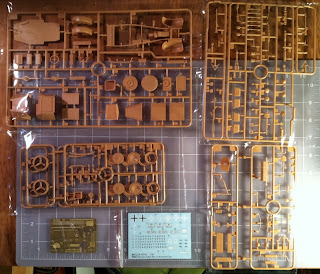At this point, the drive shaft assembly was attached to the lower hull. The kit tires were left attached and the entire unit was set on the tires to ensure that everything touched the ground. The front shock absorbers, lower rear torsion bars, front springs, and transfer case brush guard were then attached. The only fit problem encountered so far was the left front spring interfering with the steering linkage (see arrow in photo below). I'm not sure where the misalignment originated, but as a result, the steering linkage has a slight bow . . . not suited for competition, but, oh well.
To finish the undercarriage, the four rear shock absorbers, muffler and exhaust pipe assembly, and rear suspension support were added. A drill bit and pin vise were used to open the end of the exhaust pipe.
The front plate had six ejector pin marks. These were sanded out even though I later realized that the aftermarket interior plate would cover them. The two tow clevis attachments were added to the front plate and then the assembly was joined to the front of the hull. There were no issues with the fit.
The rear hull plate has two holes which must be opened if you wish to attach a first aid case in a later step. I left them closed. The two tow clevis attachments and tow pintle plate were added to the rear hull plate and the assembly was then attached to the rear of the hull, again with no fit issues.
After a final clean-up and check of the work to-date, it'll be time to tackle the interior--lots of added detail for that area! Here's a photo of the left side showing the work up to this point:
















